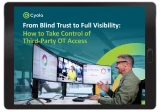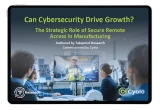Table of Contents
- Key Acronyms to Kick Off Your OT Security Education
- 1. Information Technology (IT) vs. Operational Technology (OT)
- 2. Cyber-Physical Systems (CPS)
- 3. Industrial Control Systems (ICS)
- 4. Supervisory Control and Data Acquisition (SCADA)
- 5. Secure Remote Access (SRA)
- 6. Remote Privileged Access Management (RPAM)
- 7. Demilitarized Zone (DMZ)
- 8. Programmable Logic Controller (PLC)
- 9. Human-Machine Interface (HMI)
- 10. Distributed Control Systems (DCS)
- 11. ISA/IEC 62443
- 12. NIS 2
- 13. NERC-CIP
- Wrap-up: Decode It, Don’t Fake It
Key Acronyms to Kick Off Your OT Security Education
Welcome to the world of OT security, where three-letter acronyms outnumber coffee breaks, and half the room nods along without really knowing what a PLC does.
As operational technology becomes more connected, IT security teams are being handed responsibility for infrastructure they’ve never touched before. It’s no longer just cloud apps and databases, but also pumps, robots, and factory lines. The stuff that moves physical things, not only data.
If you’re stepping over OT from the IT side, you’re not alone. A 2024 research report from Cyolo and Ponemon Insitute found that IT teams are fully or partially responsible for managing OT security in 71% of organizations.
But OT comes with its own rules, risks, and vocabulary. And let’s be honest – nobody wants to be that guy Googling acronyms mid-meeting.
So if your head’s spinning with DMZs and HMIs, take a breath. You’re in the right place (and your secret’s safe with us).
Here are 13 need-to-know definitions every new OT security pro should have in their back pocket – so you can keep your systems safe, your operations running, and your reputation intact.
1. Information Technology (IT) vs. Operational Technology (OT)
IT handles all things digital: business software, cloud apps, email servers, and internal networks. It’s built for speed and flexibility – connected, regularly updated, and designed to evolve with the business.
OT, on the other hand, runs physical processes: machinery, sensors, control panels, and production lines. These systems prioritize stability over change. They may be isolated from external networks, often rely on decades-old tech, and are rarely updated – because downtime risks severe real-world consequences.
2. Cyber-Physical Systems (CPS)
CPS combine sensors, software, and physical components to interact with the real world in real time. Think robotic arms adjusting movement on a production line or automated vehicles navigating warehouses.
They’re the backbone of smart factories and industrial automation – powerful, fast, and deeply connected.
But with that connectivity comes risk. Each integrated component becomes a potential entry point for attackers, especially in environments where cybersecurity wasn’t baked in from the start.
3. Industrial Control Systems (ICS)
ICS are the control rooms of the OT universe. If IT systems are the brains, ICS are the nerves and muscles
Made up of hardware, software, and networked devices, ICS monitor and control physical processes – from water treatment to mining operations.
Downtime isn’t just disruptive here – it can mean physical damage or safety risks. As a result, keeping industrial controls systems protected from both external and internal threats is a key priority that cannot be overstated.
4. Supervisory Control and Data Acquisition (SCADA)
SCADA systems collect and analyze real-time data from OT environments – think of them as the eyes and brain coordinating OT networks.
SCADA gives operators visibility into distributed assets – like pipelines, turbines, or manufacturing lines – and can trigger automated responses when thresholds are hit.
5. Secure Remote Access (SRA)
Secure Remote Access (SRA) refers to the tools that let users connect to internal systems from afar.
Most legacy SRAs, such as VPNs and VDI (virtual desktop infrastructure), were built for the IT world – and it shows. They’re slow, blind to what users are doing after the initial verification, and often full of security holes. That may be good enough for checking emails – but it doesn’t cut it for managing ICS and CPS.
However, more advanced SRA solutions (like Cyolo PRO) are designed specifically to meet OT needs. These tools not only grant secure access to authorized resources according to the principle of least privilege but also provide visibility and control for the entirety of each remote connection. And, according to recent research, the right SRA approach can drive not just better security outcomes but also improvements in uptime, operational agility, and business resiliency.
6. Remote Privileged Access Management (RPAM)
RPAM1 is a new solution category introduced by analyst firm Gartner in December 2023.
RPAM tools combine key capabilities of other secure access tools to better protect privileged access – or any high-risk access scenario. That means tighter controls than traditional privileged access management (PAM), better connectivity than legacy SRA, and more oversight than your average Zero-Trust Network Access (ZTNA) setup.
It’s all built on the principle of least privilege, with added capabilities and controls like password vaulting and rotation, session monitoring, just-in-time (JIT) access, and logging/auditing baked in.
Or, in plain English: verified users get access to only what they need, nothing more. And your security teams get the control and visibility they lack today.
7. Demilitarized Zone (DMZ)
A DMZ is a network buffer that allows external access to internal resources. In OT environments, it’s used to isolate sensitive assets while still enabling remote access or data sharing.
Put simply: a DMZ lets you open the gates just enough to let in support staff or software updates – without inviting trouble.
Done right, it’s a core part of network segmentation. Done wrong, it’s a hacker’s shortcut.
8. Programmable Logic Controller (PLC)
PLCs are tiny but mighty. Essentially, they’re rugged industrial computers that automate real-world processes, like starting a motor or opening a valve. In fact, they’re central to OT environments, built for reliability and expected to run for decades without failures…
So long as they’re well-protected.
If a PLC is compromised, attackers aren’t just stealing files – they’re interfering with physical equipment and processes. In OT, that’s a worst-case scenario.
9. Human-Machine Interface (HMI)
HMIs are the dashboards OT operators use to control machinery and monitor processes. They display real-time data from sensors and control systems, helping operators monitor and manage what’s happening on the ground. Think pressure readings, status lights, and emergency shutdown buttons.
HMIs are where decisions get made – and sometimes overridden. This makes them a prime target for attackers looking to manipulate systems or mask malicious actions.
10. Distributed Control Systems (DCS)
A DCS is the brain of your operation, spreading out control across multiple nodes rather than relying on a single command center. Used in process industries like oil, gas, and pharmaceuticals, it improves resilience and scalability by localizing control loops.
But more nodes mean more endpoints, and more endpoints mean more places for attackers to hide. Security here is all about visibility, segmentation, and locking down lateral movement.
11. ISA/IEC 62443
An international standard for OT cybersecurity, ISA/IEC 62443 is a must-know if you’re anywhere near manufacturing, energy, or critical infrastructure.
It provides a framework for securing industrial automation and control systems (IACS), breaking OT security into zones, layers, and maturity levels – helping organizations build a roadmap to compliance.
12. NIS 2
If you have operations in the European Union – or vendors who do – this one’s non-negotiable.
The EU’s updated cybersecurity directive for securing critical infrastructure, NIS2, requires organizations to implement robust security controls, report incidents promptly, and face penalties if they don’t.
It doesn’t tell you exactly how to comply – but it does raise the bar for visibility, resilience, and risk management.
13. NERC-CIP
If you work in the US power sector, this isn’t just the standard – it’s your rulebook.
NERC CIP is the mandatory cybersecurity standard North America’s Bulk Electric System, helping to keep the lights on – literally. It applies to anyone operating or supporting the electric grid – and covers everything from access control to incident response.
Wrap-up: Decode It, Don’t Fake It
When you first enter the world of OT, it can feel full of unfamiliar acronyms and even more unfamiliar legacy systems. But with this list in hand, you’re already ahead of the curve.
And if you’re interested in one more bonus acronym, we’ve got just the thing:
Cyolo PRO (Privileged Remote Operations), the easy-to-use OT remote access solution that can be deployed in any environment and integrates seamlessly with both modern and legacy infrastructure.
Discover the Benefits of Cyolo PRO (Privileged Remote Operations)
1 Gartner, Securing Remote Privileged Access Management Through RPAM Tools, Abhyuday Data, Felix Gaehtgens, Michael Kelley, 28 December 2023.
GARTNER is a registered trademark and service mark of Gartner, Inc. and/or its affiliates in the U.S. and internationally and is used herein with permission. All rights reserved.

Josh Martin
Author
Josh Martin is a security professional who told himself he'd never work in security. With close to 5 years in the tech industry across Support, Product Marketing, Sales Enablement, and Sales Engineering, Josh has a unique perspective into how technical challenges can impact larger business goals and how to craft unique solutions to solve real world problems. Josh joined Cyolo in 2021 and prior worked at Zscaler, Duo Security, and Cisco.
Outside of Cyolo, Josh spends his time outdoors - hiking, camping, kayaking, or whatever new hobby he's trying out for the week. Or, you can find him tirelessly automating things that do NOT need to be automated in his home at the expense of his partner. Josh lives in North Carolina, USA.

Subscribe to Our Newsletter







